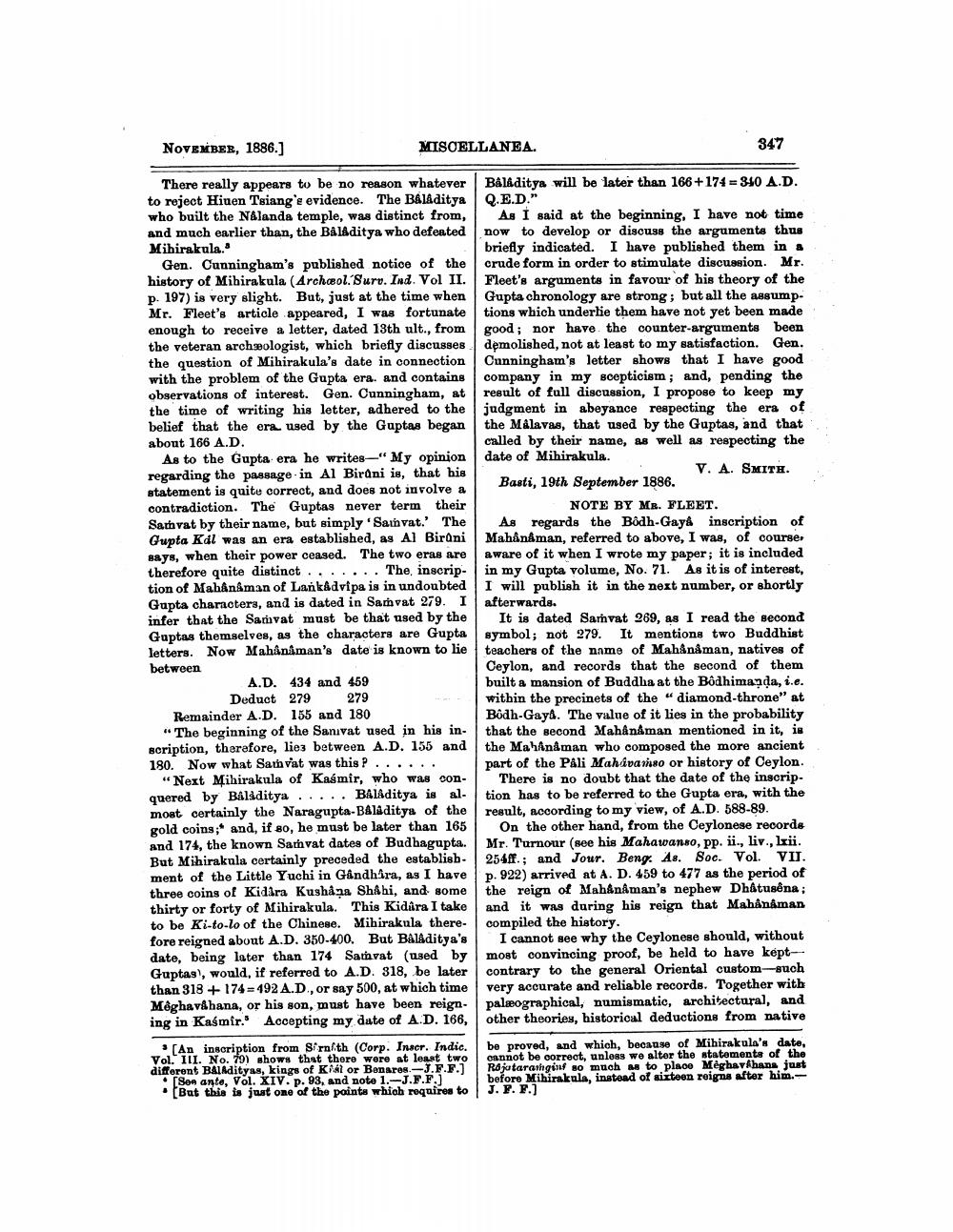________________
NOVEMBER, 1886.]
There really appears to be no reason whatever to reject Hiuen Tsiang'e evidence. The Bâlâditya who built the Nalanda temple, was distinct from, and much earlier than, the Bâlâditya who defeated Mihirakula."
MISCELLANEA.
Gen. Cunningham's published notice of the history of Mihirakula (Archeol. Surv. Ind. Vol II. p. 197) is very slight. But, just at the time when Mr. Fleet's article appeared, I was fortunate enough to receive a letter, dated 13th ult., from the veteran archeologist, which briefly discusses the question of Mihirakula's date in connection with the problem of the Gupta era. and contains observations of interest. Gen. Cunningham, at the time of writing his letter, adhered to the belief that the era. used by the Guptas began about 166 A.D.
As to the Gupta era he writes-"My opinion regarding the passage in Al Birani is, that his statement is quite correct, and does not involve a contradiction. The Guptas never term their Samvat by their name, but simply 'Samvat.' The Gupta Kal was an era established, as Al Birani says, when their power ceased. The two eras are therefore quite distinct... .... The, inscription of Mahânâman of Lankâdvipa is in undoubted Gupta characters, and is dated in Samvat 279. I infer that the Samvat must be that used by the Guptas themselves, as the characters are Gupta letters. Now Mahânâman's date is known to lie between
A.D. 434 and 459 Deduct 279 279 Remainder A.D. 155 and 180
"The beginning of the Sanivat used in his inscription, therefore, lies between A.D. 155 and 180. Now what Samvat was this?.
"Next Mihirakula of Kaśmir, who was conquered by Bâlâditya BALAditya is almost certainly the Naragupta-Bâlâditya of the gold coins; and, if so, he must be later than 165 and 174, the known Samvat dates of Budhagupta. But Mihirakula certainly preceded the establishment of the Little Yuchi in Gandhira, as I have three coins of Kidara Kushâna Shahi, and some thirty or forty of Mihirakula. This Kidâra I take to be Ki-to-lo of the Chinese. Mihirakula therefore reigned about A.D. 350-400. But Bâlâditya's date, being later than 174 Samvat (used by Guptas), would, if referred to A.D. 318, be later than 318+174-492 A.D., or say 500, at which time Mêghavahana, or his son, must have been reigning in Kasmir. Accepting my date of A.D. 166,
347
Bâlâditya will be later than 166+174-340 A.D. Q.E.D."
As I said at the beginning, I have not time now to develop or discuss the arguments thus briefly indicated. I have published them in a crude form in order to stimulate discussion. Mr. Fleet's arguments in favour of his theory of the Gupta chronology are strong; but all the assumptions which underlie them have not yet been made good; nor have the counter-arguments been demolished, not at least to my satisfaction. Gen. Cunningham's letter shows that I have good company in my scepticism; and, pending the result of full discussion, I propose to keep my judgment in abeyance respecting the era of the Mâlavas, that used by the Guptas, and that called by their name, as well as respecting the date of Mihirakula.
V. A. SMITH.
Basti, 19th September 1886.
[An inscription from Sirnith (Corp. Inser. Indic. Vol. III. No. 79) shows that there were at least two different BALAdityas, kings of Kál or Benares.-J.F.F.] [Sen ante, Vol. XIV. p. 93, and note 1.-J.F.F.] [But this is just one of the points which requires to
NOTE BY MR. FLEET.
As regards the Bôdh-Gays inscription of Mahânâman, referred to above, I was, of course. aware of it when I wrote my paper; it is included in my Gupta volume, No. 71. As it is of interest, I will publish it in the next number, or shortly afterwards.
It is dated Samvat 269, as I read the second symbol; not 279. It mentions two Buddhist teachers of the name of Mahânåman, natives of Ceylon, and records that the second of them. built a mansion of Buddha at the Bôdhimanda, i.e. within the precinets of the "diamond-throne" at Bôdh-Gays. The value of it lies in the probability that the second Mahânâman mentioned in it, is the Mahânâman who composed the more ancient part of the Pâli Mahavamso or history of Ceylon.
There is no doubt that the date of the inscription has to be referred to the Gupta era, with the result, according to my view, of A.D. 588-89.
On the other hand, from the Ceylonese records Mr. Turnour (see his Mahawanso, pp. ii., liv., lxii. 254ff.; and Jour. Beng. As. Soc. Vol. VII. p. 922) arrived at A. D. 459 to 477 as the period of the reign of Mahânâman's nephew Dhâtusêna; and it was during his reign that Mahânâman compiled the history.
I cannot see why the Ceylonese should, without most convincing proof, be held to have keptcontrary to the general Oriental custom-such very accurate and reliable records. Together with palæographical, numismatic, architectural, and other theories, historical deductions from native
be proved, and which, because of Mihirakula's date, cannot be correct, unless we alter the statements of the Rojatarahginf so much as to place Meghav hans just before Mihirakula, instead of sixteen reigns after him.J. F. F.]




